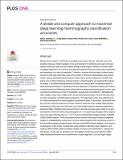Files in this item
A divide and conquer approach to maximise deep learning mammography classification accuracies
Item metadata
| dc.contributor.author | Jaamour, Adam | |
| dc.contributor.author | Myles, Craig | |
| dc.contributor.author | Patel, Ashay | |
| dc.contributor.author | Chen, Shuen-Jen | |
| dc.contributor.author | McMillan, Lewis | |
| dc.contributor.author | Harris-Birtill, David | |
| dc.date.accessioned | 2023-05-29T10:30:28Z | |
| dc.date.available | 2023-05-29T10:30:28Z | |
| dc.date.issued | 2023-05-26 | |
| dc.identifier | 286805267 | |
| dc.identifier | f989bc29-1b9a-4c68-92e7-65547f92cc7f | |
| dc.identifier | 85160380952 | |
| dc.identifier.citation | Jaamour , A , Myles , C , Patel , A , Chen , S-J , McMillan , L & Harris-Birtill , D 2023 , ' A divide and conquer approach to maximise deep learning mammography classification accuracies ' , PLoS ONE , vol. 18 , no. 5 , e0280841 . https://doi.org/10.1371/journal.pone.0280841 | en |
| dc.identifier.issn | 1932-6203 | |
| dc.identifier.other | RIS: urn:BC16C29DD716C85812F0D2622093E301 | |
| dc.identifier.other | ORCID: /0000-0002-7725-5162/work/136288566 | |
| dc.identifier.other | ORCID: /0000-0002-0740-3668/work/136288968 | |
| dc.identifier.other | ORCID: /0000-0002-2701-3149/work/155626593 | |
| dc.identifier.uri | https://hdl.handle.net/10023/27690 | |
| dc.description.abstract | Breast cancer claims 11,400 lives on average every year in the UK, making it one of the deadliest diseases. Mammography is the gold standard for detecting early signs of breast cancer, which can help cure the disease during its early stages. However, incorrect mammography diagnoses are common and may harm patients through unnecessary treatments and operations (or a lack of treatment). Therefore, systems that can learn to detect breast cancer on their own could help reduce the number of incorrect interpretations and missed cases. Various deep learning techniques, which can be used to implement a system that learns how to detect instances of breast cancer in mammograms, are explored throughout this paper. Convolution Neural Networks (CNNs) are used as part of a pipeline based on deep learning techniques. A divide and conquer approach is followed to analyse the effects on performance and efficiency when utilising diverse deep learning techniques such as varying network architectures (VGG19, ResNet50, InceptionV3, DenseNet121, MobileNetV2), class weights, input sizes, image ratios, pre-processing techniques, transfer learning, dropout rates, and types of mammogram projections. This approach serves as a starting point for model development of mammography classification tasks. Practitioners can benefit from this work by using the divide and conquer results to select the most suitable deep learning techniques for their case out-of-the-box, thus reducing the need for extensive exploratory experimentation. Multiple techniques are found to provide accuracy gains relative to a general baseline (VGG19 model using uncropped 512 × 512 pixels input images with a dropout rate of 0.2 and a learning rate of 1 × 10−3) on the Curated Breast Imaging Subset of DDSM (CBIS-DDSM) dataset. These techniques involve transfer learning pre-trained ImagetNet weights to a MobileNetV2 architecture, with pre-trained weights from a binarised version of the mini Mammography Image Analysis Society (mini-MIAS) dataset applied to the fully connected layers of the model, coupled with using weights to alleviate class imbalance, and splitting CBIS-DDSM samples between images of masses and calcifications. Using these techniques, a 5.6% gain in accuracy over the baseline model was accomplished. Other deep learning techniques from the divide and conquer approach, such as larger image sizes, do not yield increased accuracies without the use of image pre-processing techniques such as Gaussian filtering, histogram equalisation and input cropping. | |
| dc.format.extent | 24 | |
| dc.format.extent | 1880145 | |
| dc.language.iso | eng | |
| dc.relation.ispartof | PLoS ONE | en |
| dc.subject | QA75 Electronic computers. Computer science | en |
| dc.subject | RC0254 Neoplasms. Tumors. Oncology (including Cancer) | en |
| dc.subject | DAS | en |
| dc.subject | SDG 3 - Good Health and Well-being | en |
| dc.subject | MCC | en |
| dc.subject.lcc | QA75 | en |
| dc.subject.lcc | RC0254 | en |
| dc.title | A divide and conquer approach to maximise deep learning mammography classification accuracies | en |
| dc.type | Journal article | en |
| dc.contributor.institution | University of St Andrews. School of Computer Science | en |
| dc.contributor.institution | University of St Andrews. School of Physics and Astronomy | en |
| dc.identifier.doi | 10.1371/journal.pone.0280841 | |
| dc.description.status | Peer reviewed | en |
This item appears in the following Collection(s)
Items in the St Andrews Research Repository are protected by copyright, with all rights reserved, unless otherwise indicated.

